- Folio No. 9
- About
- Feral Parrot : The Blog
- INTERVIEWS
- SUBMISSIONS
-
ISSUE ARCHIVE
- PRINT Chapbook No.6 Healing Arts
- Online Issue No.9
- Online Issue No.1 Fall 2016
- Online Issue No.2 Spring 2017
- ONLINE Issue No.3 Fall 2017
- PRINT Vol 72 No 2 Fall 2017
- PRINT Vol 73 No.1 Fall 2018
- ONLINE Issue No. 4 Fall 2018
- Online Issue No.5 Summer 2018
- FOLIO No.1 Fall 2018 VOTE
- ONLINE Issue No.6 Fall 2018 Fall Spirituality
- FOLIO 2 Fall 2019 Celebrating Dia De Los Muertos
- FOLIO No.3 -- Moon Moon Spring 2019
- FOLIO No.4 Celebrating New PCC Writers
- FOLIO No.5 City of Redemption
- FOLIO No.6 Spring 2020
- FOLIO No. 7 - Winter 2021 Into the Forest
- 2022 Handley Awards
- Inscape Alumni Board
- PRINT Chapbook No. 7 Healing Arts
- Blog
- Untitled
Written by Adrine ArakelianIn Follow Her Home, Steph Cha turns the story along the streets of Los Angeles. Its past and present are key figures in her writing. She compares her protagonist, Juniper Song’s, experience of Los Angeles to Marlowe’s, the city of today to that of yesterday. She writes, “Marlow didn’t live in a city of skyscrapers. The City Hall was the lone exception, the tallest building he knew by at least a hundred feet. It was still around, a designated landmark from another era, but its tower was quietly outgrown by a number of nameless office buildings” (106). She does this again, calling out the Wiltern Theater in Koreatown, “We turned right at the Wiltern, a landmark theater with an ancient marquee, a place that had seen Koreatown sprout up and around it, leaving no lot unturned” (134). Cha refers repeatedly to vestiges of the city, the survivors of change, the benchmark to which the new blocks are measured, what it is to what it once was. In Song’s own experience, there is her life before her sister’s suicide, and the life after, the key event around which her own life spins. Her sister’s troubles are the reason she turned to sleuthing and stayed with the danger of her friend, Luke’s request. Time passes, Song’s days go by without major commitments or life direction, the unchanging element is her sister’s suicide and Song’s feelings of guilt. These points in time stand, while the rest of her life turns over, unremarkable as a nameless office building, uneventful until now. Cha wraps the novel around Luke’s apartment building, The Marlowe, in Hancock Park. The novel begins and ends there, twisting and turning along the way. Luke’s suspicions about his father’s affinity for a young Korean woman, Lori, are revealed to Song at Luke’s house party in the first pages of the novel. By the time we reach the end, Song sees Luke for the person he is, hurt by the choices he’s made, and no longer wishes to know him. Her best friend and only love is dead because of Luke’s family and his inability to intervene. She now has two key people in her life who have died, and both are in some way associated with her investigating. Since Cha’s grounding of the novel in space is part of what makes it tangible, what drives the sensory appeal of it. I wondered, why locate the key moments of the novel in Hancock Park? The author, Steph Cha, lives near the neighborhood, but the location means more. Hancock Park is where the gridded streets of Hollywood begin their swerve and sway southward, where the clear lines of palm trees are replaced by the shade of sycamores. I followed Song’s trail, sleuthing around Hancock Park to find the locations that drive Cha’s storytelling. Inspired by Cha’s Yelping hobby, this is my ode to her habit and her depiction of sun-kissed noir in LA. Hollywood’s Vine Street hits Melrose and turns into Hancock Park’s Rossmoor Avenue, Vine’s picturesque southern half. Cha doesn’t say this, but Rossmoor is a pleasure to drive, one of the few LA streets whose sweep embraces you, maybe it’s the manicured estates, the lush greenery, the curving roads after the hard light of the linear grid. Every apartment building proudly announces its claim to Hancock Park. In this apartment district, the historic buildings hug the sidewalk, creating a narrow corridor through which you move, one of the few, in a mostly horizontal city. The Ravenswood greets you with its Art Deco lines bringing your eyes skyward, to the bright blue cloudless expanse. The mashup aesthetic that most characterizes this neighborhood would be called Art Deco château, mansard roofs with zigzag patterned stairs, a wonderful mishmash of styles. Everything is now leasing, now renting, a city on the move. It makes sense that as Cha opens the novel, Luke has just moved into his new pad at The Marlowe. 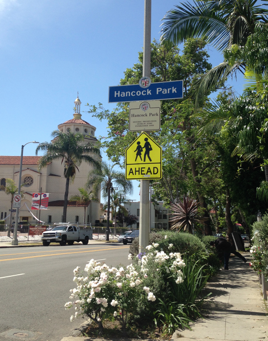 Photo by Adrine Arakelian Photo by Adrine Arakelian Hancock Park is a designated historic district in LA. Signs proudly announce your entrance to the neighborhood, as does the greenery and sycamore trees lining the streets with more consistency than anything else in the city. It is without a doubt the lushest neighborhood of LA, evidence of its wealth and the status of its residents. This is a well-kept neighborhood not known for high crime. According to my friend who once worked for CD4, Councilman Ryu’s district, it is better known for the constant complaints of the homeowners against the apartment dwellers. A battle over the rights to empty streets, over who is parking cars where. In many ways, our homes bring out the most territorial and often the most petty in us. But even the apartments in the neighborhood are no ordinary set of multi-story structures. 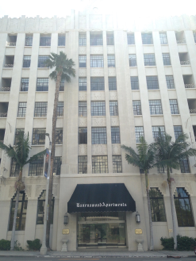 Photo by Adrine Arakelian Photo by Adrine Arakelian I walked around trying to locate Luke’s apartment building, The Marlowe. Google indicated it existed. The Ravenswood is not the building where Luke is supposed to be living, but its clean, vertical Art Deco lines are characteristic of some of the eye-catching architecture in the neighborhood. On a windswept Friday afternoon, it was just I and the hired building landscaping crews out, walking around. Though Rossmoor is a popular north-south byway, so there was no end to the rushed line of cars making their way to Hollywood or Mid-City. 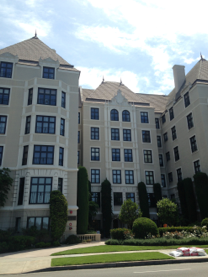 Photo by Adrine Arakelian Photo by Adrine Arakelian I kept walking, in search of the most French-inspired apartment building, per Song’s references to the fleur-de-lis blossoming all the over the structure. While the County Club Manor is without a doubt the most luxurious in appearance, there was not a fleur-de-lis to be found on its edifice. Though its front garden and mansard roof do their best to imitate the French chateau style. If I had the chance to live in this place, I certainly would not turn that down. 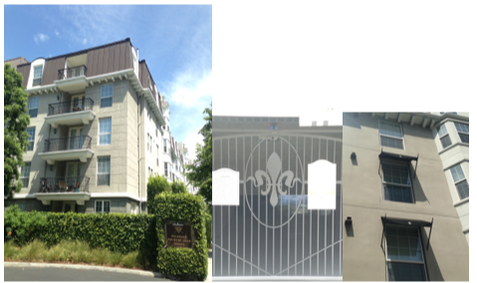 Photo by Adrine Arakelian Photo by Adrine Arakelian However, it was actually the Windsor that Google identified as The Marlowe. I can’t say I was not disappointed. The aesthetic is more in line with nameless corporation does 1990s take on the French chateau. It has the bland, luxury apartment feel we see popping up all over LA with fleur-de-lis stamped all over the place for flair. Given Luke’s character, that he ends up being a disappointment and a failure as a friend, the location and lack of character of his residence is fitting. He doesn’t deserve the Ravenswood or Country Club Manor. I’ve never done a Yelp review, so I’ll end with a Steph Cha’s style Yelp review of one of my favorite eateries in LA, a rare luxurious treat. After my amble through Hancock Park, I made a necessary sustenance detour and kept walking to LaBrea for lunch at Republique. The space was brightly lit, with the sparkling sound of clinking glasses and cutlery. The Smiths played in the background. The light-filled interior is a mash up of an indoor atrium space and an outdoor covered courtyard. White tile gives way to white brick, with a zigzag patterned blue and green ceramic tile floor. The main hall evokes an interior and exterior space at once, with triple height, skylit ceilings and long wooden communal tables. The entryway is lined with glowing jars of preserved lemon and cloves. A delectable row of sweet and savory pastries greets you upon entry. Your eye makes its way panning across the selection, salivating at the endless and overwhelming choice of options. Other than the loud noise of the interior, how can you not love this place? I was seated at the bar, in a slightly dimmer corner of the eatery, with a view into the open kitchen backed with night blue ceramic tiles glistened by the fire of the oven. I ordered a drip coffee, which comes in a tall silver canister, the burrata toast, and a chocolate hazelnut croissant for take-away. The burrata toast had the textural and flavor mix of crunchy, sweet, and roasted vegetables, topped with a sunny side up egg, all laid on top of cheesed toast. A delicate cherry tomatoes burst from its skin and into my mouth, with the crunch of toast and saltiness of the burrata cheese. The porous toast soaked up all the drippings, but maintained the crunch of its crust. I went on my own and there's a luxury in eating alone, the flavors uninterrupted by conversation. I was seated at the bar in between a woman working away at her laptop, with coffee and a pastry, and a platinum blonde woman, in a sleek black dress, a vision of the perfectly coiffed diet-conscious, sipping a chilled white wine and nipping at a salad, red lipstick not even smudged from the meal. Her eyes were glued to her smartphone, the ultimate sign of a high-powered working lunch. Laptops are for the hustling younger set. If Kerouac were alive today, even he might be speaking his next book into his smart phone. Down the bar was a male trio crowding around their tall slices of moist and creamy chocolate cake. I sat back, sipping my coffee and taking in my meal, savoring the mix of sweet, salty, melted crunch, lapping it up to the last dribble. Adrine Arakelian is a life-long student and urban planner. She says, "I care about places and value the pedestrian experience. I process the world through words. PCC is where I started my higher education and has been continued source of enrichment."
0 Comments
Leave a Reply. |
IMPORTANT NOTE:
PCC Inscape Magazine, housed at Pasadena City College, is following Coronavirus protocols. At this time our staff continues to read submissions and publish web content. Note:
Blog Posts reflect the opinions of the writer and not the opinions of Pasadena City College or Inscape Magazine Editorial Staff Members. Archives
December 2023
Categories
All
|

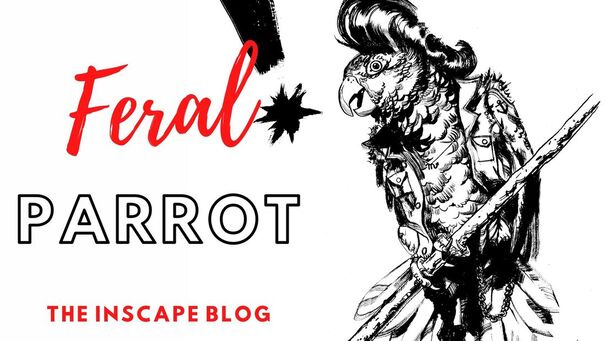
 RSS Feed
RSS Feed